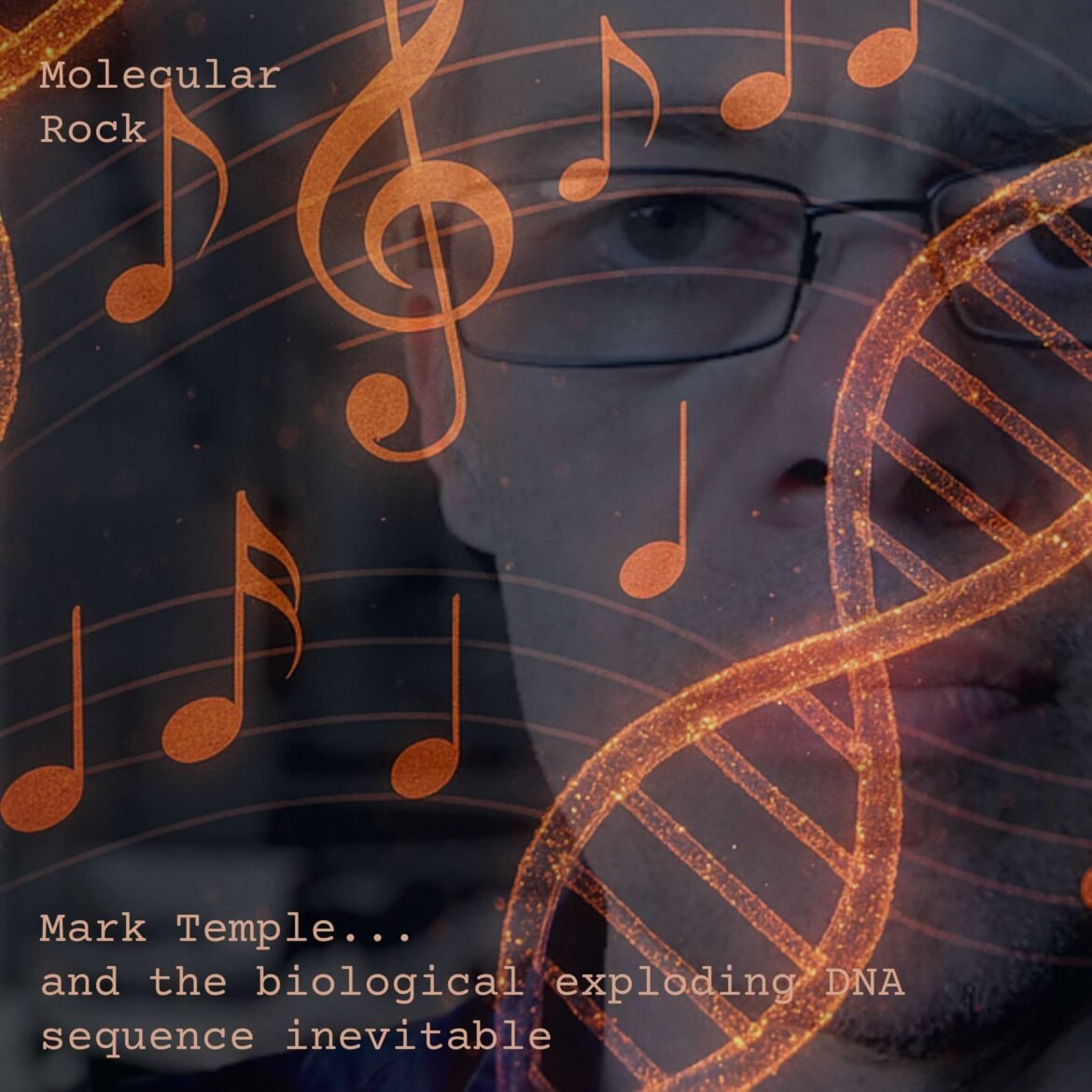Mark Temple and ‘the Biologically Exploding DNA Sequence Inevitable’ have just released their second DNA inspired album Molecular Rock. This concept album is hardly surprising given Marks background as an academic in Molecular Biology and former member of Sydney’s sorely missed pop pioneers The Hummingbirds.
In the science world Mark uses audio for DNA sequence analyses with a technique called sonification, in the creative world Mark turns this audio into music; the gene sequences become a dominant musician! The appropriately titled ‘Biologically Exploding DNA Sequence Inevitable’ play a self-described style of early 1970’s inspired krautrock music to accompany the DNA sequences.
Media quotes for Marks work “this is just amazing” NPR, “beautiful and ethereal” New Scientist, “a musical masterpiece” Science Line, “as cool as it sounds” 3MBS Fine Music, “surprisingly lovely” The Conversation, and “I friggin love the music” Jules (Phantom Records).
The album will be launched at Sydney Opera House on Tuesday, August 12th as part of National Science Week.
The result is a rhythmic, and unpredictable soundscape that is scientifically authentic and sonically adventurous. Taking the science audio into the recording studio was an act of bravado… and as ChatGPT poorly suggested – it’s an act of gene-ius!
This DNA-inspired music follows his earlier RNA inspired CoronaCode Music album. Whilst you might need a textbook to understand the theory, fear not… the music grabs you by the ears and drags you out of the laboratory and into the creative space.
Molecular Rock speaks to the DNA sequences of Eucalyptus trees and the plant pathogen Myrtle rust. DNA sequences were converted into musical structures – mapping A, T, C, and G mono-nucleotides, di-nucleotides, and tri-nucleotides (codon) into sound. These biologically important genetic patterns act as the foundation for the album’s tracks, making pulsating rhythms and synthesiser sequences. Feel free to release your inner-scientist and read about Mark’s publications at BMC Bioinformatics.
Editing DNA sequences for music composition
The systematic nature of sonification ensures the same DNA sequence always produces the same audio, which supports scientific analyses, and more recently this has been adapted for music composition. In this case the DNA sequences are written from scratch for the sole purpose of music composition, imitating the DNA editing techniques that emerged in the 1980’s. This is described in a recent The Conversation article ‘Forget AI-generated music, this music was composed using DNA sequences’.
Please excuse the quip about AI generated music… but there is a similarity regarding the use of algorithms to generate ‘the thing we might listen to’. I am unsure if AI music can be perceived as authentic, I assume that AI it’s trawling the back catalogue of creative artists who have been an inspiration to many of us and it is regurgitating pale imitations. I don’t want AI to make music; I want AI to do the things that are tedious and boring so that I can focus on things that are creative and interesting. To me music is about noodling on drums or guitar to make yourself feel better, it’s about playing with other people and having that deep connection, and its about listening to music that speaks to my world view. It’s not about AI surreptitiously leading us away from real music. I know, I know… its contentious.
The audio from the biological data is a different beast, its robotic and systematic and designed for DNA sequence analyses, it can only sound monotonous. I can convince myself for short listens that it sounds like a Gameboy and indeed many commentators say nice things about it. I can manipulate the instrument used and turn the bleeps to MIDI and imitate musical instruments. I think this sounds better but importantly, unlike AI, I have not trolled anyone’s back catalogue and infringed on copyright (or should I say livelihood) to make something that is beginning to sound harmonious and possibly musical.
The glorious intersection of science and art.
The fun aspect to this ongoing narrative is that the DNA audio can be used as a backing track and I find myself in the studio recording Molecular Music, long after the demise of my sorely missed Hummingbirds. And in preparation for the Sydney Opera House show, I am again rehearsing with real people and with real instruments loudly over the top of the DNA sequences… as I consider going deaf for a living.
The recordings were made with ARIA Award-winning producer Wayne Connolly. In an unorthodox process, musicians recorded their parts without hearing what the others had played, responding only to Temple’s recorded drum performances and the beep bleeps of the DNA sequences. This approach captured the raw creative process blending science and art, and provided an opportunity for post-production arrangement of the recorded parts by Temple.
Artist Profile: Mark Temple
Mark Temple is a Senior Lecturer in the School of Science at Western Sydney University and a member of MARCS. He is known to many as founding member of Sydney’s beloved indie-rock band ‘The Hummingbirds’. Over the last decade, he has carved out a niche at the intersection of science sonification, and experimental music in his out-reach activities. His work brings together data science and musicians to create sonic experiences rooted in molecular biological, whilst still staying true to his indie-rock origins.
Project Partners and Support
Synthetic Compositions at the Sydney Opera House is an Inspiring Australia NSW initiative supported by the Australian Government as part of National Science Week, in partnership with the School of Science and The SEED Lab at Western Sydney University. The Australian Plant Biosecurity Science Foundation supported the Molecular Rock album as out-reach to highlight the devastating effects Myrtle rust is having upon Australian native vegetation.
Visit me on social media:
Author Contact
Mark Temple
m.temple@westernsydney.edu.au



